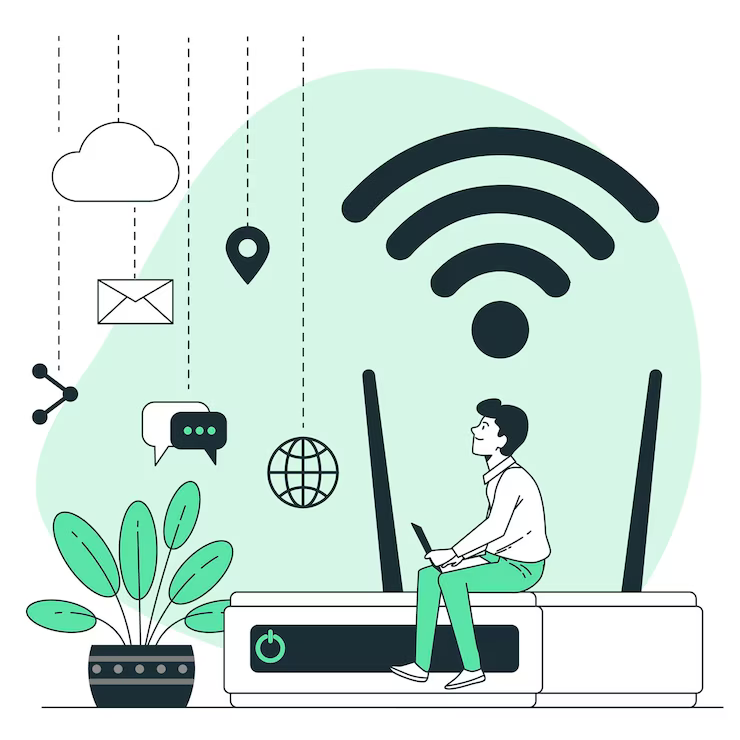Table of Contents
- Introduction
- II. The Birth of the Internet
- III. The Internet Infrastructure
- IV. How Data Travels
- V. Connecting Devices
- VI. The World Wide Web (WWW)
- VII. Internet Protocols and Standards
- VIII. Internet Security and Privacy
- IX. The Future of the Internet
- X. Summary and Conclusion
- XI. Frequently Asked Questions (FAQs)
Introduction
The Internet has permeated every aspect of our lives, revolutionizing the way we communicate, work, and access information. It has become an indispensable tool that connects billions of people worldwide. In this article, we will embark on a journey through the intricate workings of the Internet, unraveling its mysteries, and discovering the vast potential it holds.
II. The Birth of the Internet

A. Origin and Purpose
The concept of the Internet originated from the need for a decentralized communication network that could withstand potential nuclear attacks. In the 1960s, the United States Defense Department’s Advanced Research Projects Agency (ARPA) conceptualized a network that could connect computers across different locations, ensuring uninterrupted communication even in times of crisis.
B. ARPANET: The Precursor
ARPANET, established in 1969, served as the foundation for the development of the Internet. It interconnected four universities, allowing them to share resources and research findings. Over time, ARPANET expanded further, connecting more computers and institutions, ultimately setting the stage for the global network we know today.
III. The Internet Infrastructure

A. Internet Service Providers (ISPs)
Internet Service Providers (ISPs) play a vital role in connecting users to the Internet. They provide access to the global network through various technologies such as dial-up, broadband, or fiber-optic connections. ISPs act as intermediaries, routing data packets between computers and ensuring a seamless connection.
B. Network Architecture
The Internet is a complex web of interconnected networks. It follows a hierarchical structure, with multiple tiers responsible for handling different aspects of data transmission. At the top level, we find the backbone networks, which handle large volumes of data flow. Below that, we have regional networks and local networks, ensuring data reaches its intended destination efficiently.
C. Data Centers
Data centers serve as the nerve centers of the Internet. They house vast quantities of servers that store and process data, ensuring its availability and fast retrieval. These centers are carefully designed to provide optimal security, power, and cooling, enabling seamless data storage and transfer.
IV. How Data Travels

A. Transmission Control Protocol/Internet Protocol (TCP/IP)
TCP/IP is the fundamental protocol that drives data transmission over the Internet. It breaks down data into smaller packets, assigns them unique identifiers, and ensures their reliable delivery to the intended recipient. By dividing data into packets, TCP/IP allows for efficient transmission, even if the packets take different routes to reach their destination.
B. Routing and Packets
Data is divided into packets to facilitate efficient transmission across networks. Routers act as the traffic controllers, directing packets along the most optimal paths. These routers examine packet headers, determining the next hop until the packets reach their final destination, where they are reassembled into the original data.
C. Domain Name System (DNS)
The DNS serves as the Internet’s address book, translating human-readable domain names into machine-readable IP addresses. When we enter a website’s domain name into a web browser, the DNS translates it into the corresponding IP address, allowing us to access the desired website.
D. Internet Exchange Points (IXPs)
Internet Exchange Points (IXPs) are crucial meeting points where various networks connect and exchange data. They facilitate efficient and fast data transfer between different Internet Service Providers (ISPs) and content delivery networks, reducing latency and improving user experience.
V. Connecting Devices
A. Modems and Routers
Modems and routers are the gateways that connect devices to the Internet. A modem translates the digital data from a device into a format that can be transmitted through the Internet service provider’s infrastructure. Conversely, a router directs the traffic between devices within a local network and the wider Internet.
B. Wi-Fi and Network Security
Securing wireless connections is essential to protect sensitive data from unauthorized access. Encryption protocols such as WPA2 ensure that data transmitted over Wi-Fi networks remains private. Coupled with best practices such as using strong passwords and keeping software up to date, users can safeguard their network security.
VI. The World Wide Web (WWW)
A. Hypertext Transfer Protocol (HTTP)
HTTP is the foundation of web communication, enabling the retrieval and display of web content. It enables the communication between web clients (browsers) and web servers, allowing the transfer of hypertext, images, videos, and other multimedia elements. HTTPS, a secure version of HTTP, provides encrypted communication, ensuring data integrity and confidentiality.
B. Website Hosting and Servers
Websites are hosted on servers, powerful computers that store website files and deliver them to users’ browsers upon request. These servers play a crucial role in ensuring the availability and accessibility of websites worldwide.
C. Web Browsers
Web browsers act as gatekeepers to Internet content, allowing users to access websites, view multimedia content, and interact with various online applications. Popular web browsers such as Google Chrome, Mozilla Firefox, and Safari constantly strive to enhance user experience, offering features like tab management, bookmarking, and extensions.
VII. Internet Protocols and Standards
A. IP Addresses and IPv6
IP addresses are unique numerical identifiers assigned to devices that connect to the Internet. The transition from IPv4 to IPv6 became necessary due to the exhaustion of IPv4 addresses. IPv6 introduced a much larger address space, enabling the growth of connected devices and facilitating the future expansion of the Internet of Things (IoT).
B. HTML, CSS, and JavaScript
Hyper Text Markup Language, CSS, and JavaScript are essential web coding languages that enable the creation of interactive and visually appealing webpages. HTML provides the structure, CSS controls the design and layout, and JavaScript adds functionality, allowing webpages to respond to user actions.
C. File Transfer Protocol (FTP)
FTP is a protocol used for transferring files over the Internet. It allows users to upload and download files to and from remote servers, making it a valuable tool for website maintenance, file sharing, and backup tasks. However, FTP lacks strong security features, making it susceptible to unauthorized access and interception.
VIII. Internet Security and Privacy
A. Cyber Threats
The Internet is rife with cyber threats such as malware, phishing, and hacking. Understanding these risks is crucial to safeguarding personal information, sensitive data, and financial transactions. Employing robust cybersecurity measures, such as using antivirus software, practicing safe browsing habits, and regularly updating software, helps mitigate these threats.
B. Secure Sockets Layer/Transport Layer Security (SSL/TLS)
SSL/TLS protocols secure data transmission over the Internet by encrypting the connection between web clients and servers. These protocols utilize digital certificates to verify website authenticity and establish secure communication channels. SSL/TLS plays a pivotal role in protecting sensitive information during online transactions, preventing unauthorized access and data interception.
C. Virtual Private Networks (VPNs)
VPNs provide users with a secure and anonymous browsing experience by masking their online activities and encrypting their data. By routing Internet traffic through encrypted tunnels and using IP address masking techniques, VPNs safeguard privacy and protect against surveillance and data interception.
IX. The Future of the Internet
A. Internet of Things (IoT)
The Internet of Things (IoT) refers to the interconnected network of everyday objects embedded with sensors and software, allowing them to collect and exchange data. From smart homes to wearable devices, the IoT promises convenience and efficiency. However, concerns over privacy, security, and data ownership accompany this rapidly expanding network.
B. Artificial Intelligence (AI) and Machine Learning
Artificial Intelligence and Machine Learning technologies are revolutionizing the capabilities of the Internet. They enable personalized experiences, predictive analytics, and automation of various processes. However, striking a balance between leveraging AI-driven technologies and addressing ethical concerns and human impact is crucial.
C. Internet Regulation and Net Neutrality
Internet regulation and the concept of net neutrality are subjects of ongoing debates. Regulations seek to protect consumer interests, curb cybercrime, and ensure equal access to Internet resources. However, maintaining net neutrality, which advocates for equal treatment of all Internet traffic, is essential to prevent discrimination and maintain an open and free Internet.
X. Summary and Conclusion
Our journey through the intricacies of the Internet has uncovered its omnipresence, impact, and immense potential. From its humble origins as a decentralized communication network to the complex infrastructure and protocols that drive its worldwide connectivity, the Internet has reshaped our lives and opened up new possibilities. As we continue to explore the future of this enigma, let us recognize its indispensability and work towards maximizing its benefits while addressing the challenges it brings.
XI. Frequently Asked Questions (FAQs)
A. How does the Internet reach remote areas?
In remote areas, the Internet reaches through various means, including satellite connections, cellular networks, or the utilization of long-range Wi-Fi technology. These technologies extend Internet access to regions that are geographically isolated, providing connectivity to even the most remote areas.
B. How can one maintain Internet speed and reliability?
To maintain Internet speed and reliability, users can employ measures such as optimizing their Wi-Fi network, monitoring and managing bandwidth usage, and keeping their devices and software updated. Additionally, choosing reliable Internet Service Providers (ISPs) and using wired connections instead of Wi-Fi can contribute to a more stable and faster Internet experience.
C. What potential dangers lurk on the Internet?
The Internet poses various dangers, including malware infections, identity theft, online scams, and cyberbullying. Users must remain vigilant and adopt security measures, such as using strong passwords, avoiding suspicious websites and downloads, and regularly updating security software.
D. Can the Internet ever become completely decentralized?
While decentralization has been a recurring topic, achieving a completely decentralized Internet is challenging due to the complex infrastructure and centralized control of certain key aspects. However, initiatives like blockchain technology and peer-to-peer networks are exploring decentralized alternatives in specific areas, such as data storage and domain name resolution.
E. What role does the government play in Internet governance?
Governments play a crucial role in Internet governance, implementing regulations and policies that shape its usage, accessibility, and security. They work alongside international organizations, private sector entities, and civil society to address technical, legal, and socioeconomic aspects of the Internet, ensuring a balanced approach to its governance.
Follow us on our Instagram – @squarebox.in
Read more interesting articles and blog by clicking here.




